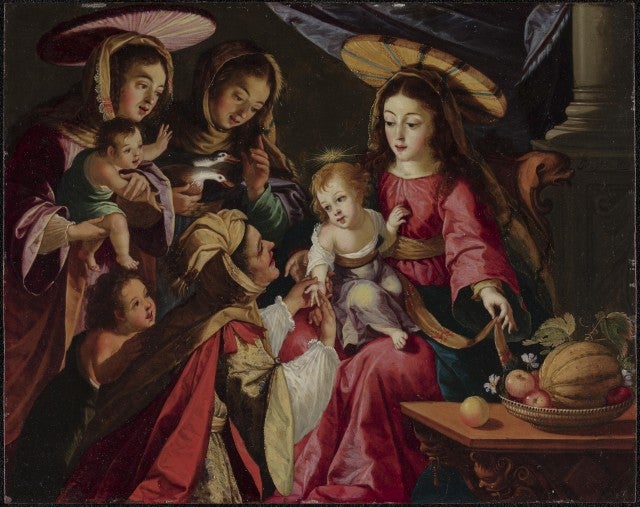From the Director, March 2021
Updated Jul 20, 2022
New acquisition
It was almost 25 years ago, during a business trip to London, that I first saw the work of the artist Josefa de Ayala, also known as Josefa de Óbidos. Her paintings were on view at the European Academy for the Arts and included a number of still-life and religious images. I was so impressed with the show that I bought two copies of the beautifully illustrated exhibition catalogue; one as a gift for an art historian friend and the other I still treasure as a memory of a new learning experience. While Josefa was born and grew up as child in Seville (Spain) during the first half of the seventeenth century, her father was from Portugal, where she ended up living and working as a painter most of her life. She is, in fact, recognized today as one of the greatest Portuguese artists of the Baroque period, and the most important female Portuguese painter before Modernity. These are remarkable achievements if we consider that the painting profession at the time was dominated almost exclusively by men and that she mostly worked in the provincial town of Óbidos (Portugal), away from major artistic centers.
Her life was fascinating. She first worked in the studio of her father, also a painter, and later, because of her talent, became an independent artist gaining civil and economic independence as a legally free person. To better comprehend this achievement, it is important to remember that society at the time would not recognize women as individuals with sufficient legal personality to sign notarial or commercial contracts; they could only sign with the authorization of a guardian, a father, or a brother. Josefa was not only able to legally emancipate but also to become both a successful artist and a businesswoman, amassing an important fortune that allowed her to acquire land and a large house in Óbidos where she moved with her servants.

Josefa’s painting is now on view in the Edna Burian Skelton Gallery, the south spine of the DIA galleries next to the sculpture The Virgin of Solitude, by Luisa Roldán, known as La Roldana, who was sculptor to King Charles II and the most important female artist of the Spanish Golden Age. These two pieces are some of our latest additions of works by women artists to the DIA collection as we continue to work towards representational equity in our galleries. It is the commitment of the organization to raise awareness and address the historical collecting imbalances through art acquisitions, programs, and exhibitions. In fact, in February 2022 the DIA will be opening the exhibition By Her Hand, Artemisia Gentileschi and Women Artists in Italy 1500 – 1800, which will feature our masterpiece by Artemisia and many other works by Italian female artists loaned by museums in the U.S. and in Europe. This exhibition will be the first one the DIA organizes devoted to women artists before modern times.
In March, we celebrate Women’s History Month and March 8 is International Women’s Day. Please keep this in mind when you come to the DIA to learn and be inspired by the art and stories of Josefa de Óbidos, Luisa Roldán, Mickalene Thomas, Artemisia Gentileschi, Mavis Pusey, Ebony G. Patterson, Jennifer Bartlett, and many others as we continue to increase the visibility of women’s creativity and to raise awareness of gender equality, inclusivity, and women’s empowerment in the field of museums and the arts in general. Although awareness of gender inequities has increased since the time I first learned about Josefa de Obidos’ paintings in London, we still have a lot of work to do to make this a better world and a more just society. You have my commitment that the DIA will do its part.

DIA Director Salvador Salort-Pons pictured wearing a blue suit and standing in front of the museum
New acquisition
It was almost 25 years ago, during a business trip to London, that I first saw the work of the artist Josefa de Ayala, also known as Josefa de Óbidos. Her paintings were on view at the European Academy for the Arts and included a number of still-life and religious images. I was so impressed with the show that I bought two copies of the beautifully illustrated exhibition catalogue; one as a gift for an art historian friend and the other I still treasure as a memory of a new learning experience. While Josefa was born and grew up as child in Seville (Spain) during the first half of the seventeenth century, her father was from Portugal, where she ended up living and working as a painter most of her life. She is, in fact, recognized today as one of the greatest Portuguese artists of the Baroque period, and the most important female Portuguese painter before Modernity. These are remarkable achievements if we consider that the painting profession at the time was dominated almost exclusively by men and that she mostly worked in the provincial town of Óbidos (Portugal), away from major artistic centers.
Her life was fascinating. She first worked in the studio of her father, also a painter, and later, because of her talent, became an independent artist gaining civil and economic independence as a legally free person. To better comprehend this achievement, it is important to remember that society at the time would not recognize women as individuals with sufficient legal personality to sign notarial or commercial contracts; they could only sign with the authorization of a guardian, a father, or a brother. Josefa was not only able to legally emancipate but also to become both a successful artist and a businesswoman, amassing an important fortune that allowed her to acquire land and a large house in Óbidos where she moved with her servants.

Josefa’s painting is now on view in the Edna Burian Skelton Gallery, the south spine of the DIA galleries next to the sculpture The Virgin of Solitude, by Luisa Roldán, known as La Roldana, who was sculptor to King Charles II and the most important female artist of the Spanish Golden Age. These two pieces are some of our latest additions of works by women artists to the DIA collection as we continue to work towards representational equity in our galleries. It is the commitment of the organization to raise awareness and address the historical collecting imbalances through art acquisitions, programs, and exhibitions. In fact, in February 2022 the DIA will be opening the exhibition By Her Hand, Artemisia Gentileschi and Women Artists in Italy 1500 – 1800, which will feature our masterpiece by Artemisia and many other works by Italian female artists loaned by museums in the U.S. and in Europe. This exhibition will be the first one the DIA organizes devoted to women artists before modern times.
In March, we celebrate Women’s History Month and March 8 is International Women’s Day. Please keep this in mind when you come to the DIA to learn and be inspired by the art and stories of Josefa de Óbidos, Luisa Roldán, Mickalene Thomas, Artemisia Gentileschi, Mavis Pusey, Ebony G. Patterson, Jennifer Bartlett, and many others as we continue to increase the visibility of women’s creativity and to raise awareness of gender equality, inclusivity, and women’s empowerment in the field of museums and the arts in general. Although awareness of gender inequities has increased since the time I first learned about Josefa de Obidos’ paintings in London, we still have a lot of work to do to make this a better world and a more just society. You have my commitment that the DIA will do its part.

